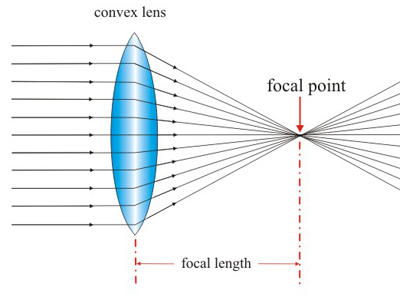Optical Basics: The Nature of Light and Optical Elements
Introduction
Optics is a branch of physics that studies the behavior and properties of light. This article aims to provide a comprehensive understanding of essential Optical Basics, ranging from the nature of light (including wavelength, the electromagnetic spectrum, phase and amplitude, the wave-particle duality of light, to reflection, refraction, birefringence, and interference) to the operation principle of optical elements. This article is a quick, straightforward guide for beginners delving into the captivating world of optics of the essential optical concepts with graphic illustrations. if you know nothing about optics, this article is right for you. Building up these basic concepts could be very helpful if you are a starter in the optical area, the optical basics are the fundamental ground of the diverse technologies in the domain of optics.
Trailer: This article will walk you through:
- Wavelength
- Ultra-Violet Spectrum
- Visible Spectrum
- Infrared Spectrum
- Phase and Amplitude
- The Wave-Particle Duality of Light
- Reflection
- Refraction
- Birefringence
- Diffraction
- Interference
- Optical Elements
You could also learn more about optical basics from our knowledge series:
Optical Basics: Spherical Aberrations and Coma
Chromatic Aberration, Field Curvature, Distortion, Astigmatism
Optical Basics: What is FOV (Field of View)
In the future, we will be covering more topics about optical basics, bookmark this article so that you can follow our updates.
Wavelength
Light is regarded as a form of electromagnetic radiation (which, according to the theory of Maxwell, are transverse waves consisting of oscillating electric and magnetic fields. Electromagnetic radiations can also be defined as the waves that travel through space with the speed of 3x10^8m/s). Wavelength is a fundamental property of light waves and represents the distance between two consecutive points in a wave cycle. It is commonly denoted by the Greek letter λ. Wavelength determines the color of light, with shorter wavelengths corresponding to higher energy and vice versa. Different wavelengths compose the electromagnetic spectrum. Ranging from the shortest wavelengths to the longest wavelengths, there are Gamma Rays (<0.01nm), X-rays (0.01-10nm), Ultra-violet radiations(10-400nm), Visible radiations(400-700nm), Infrared radiations(700nm-millimeters), Microwaves(millimeters-centimeters), Radiowaves(millimeters-kilometers). The applications are different corresponding to the different spectral regions, for example, Gamma rays and X-rays are often used in medical treatment, whilst infrared light could utilized in thermal imaging, and UV light can be harnessed in sterilization. The spectral regions most pertinent to optics are the Ultraviolet, the Visible, and the Infrared.
Ultra-Violet Spectrum
Ultraviolet light is produced when the outer electrons of atoms are excited. The ultraviolet (UV) spectrum has shorter wavelengths than visible light, falling in the range of 10 to 400 nanometers. UV radiation is responsible for effects such as sunburn, and it is widely used in sterilization processes and fluorescent lighting. UV light itself could be separated into different wavebands like Vacuum-Ultra-Violet(VUV, 100-200nm), Super-Ultra-Violet(10-150nm), etc.
Visible Spectrum
The visible light spectrum is the segment of the electromagnetic spectrum that the human eye can view, ranging from 400 to 700 nanometers. The visible color range consists of seven colors: violet, indigo, blue, green, yellow, orange, and red.
Infrared Spectrum
Infrared (IR) light has longer wavelengths than visible light, ranging from approximately 700 nanometers to 1 millimeter. The IR spectrum is positioned between the visible region and the microwavs. In physics, any substance beyond absolute zero (0K, equal to -273.15°C) emits infrared radiation. It is invisible to the human eye but finds applications in night vision, communication, and various industrial production. In fact, the heat from the sun is transferred to e the earth mainly in the form of IR emission. The infrared spectrum itself can be divided into different wavebands, such as Near-Infrared(NIR, 0.9-1.7micro), Short-Wave-Infared(SWIR, 0.9-2.5micro), Mid-Wave-Infrared(MWIR, 3-5micro), Long-Wave-Infrared(LWIR, 8-12micro), etc.

Figure 1. The Electromagnetic Spectrum
Phase and Amplitude
Phase refers to the position of a point in a wave cycle, It is a measure describing the waveform change of the signal or the stage of the periodic motion of an object. The measuring unit is degree, the signal waveform changes in a periodic manner, and when one full cycle is completed, the phase is 360°. The phase could also be converted into π, where 2π stands for a full cycle.
Assume the period for the motion is T, the phase at a random time point t could be calculated as:
F(t)=2π[(t-t0)/T]
Phase is also an important concept to take into account in situations when several light signals exist. The differences in the phases of the light signal might create constructive or destructive interference, which will result in the magnification or the attenuation of the signals.
Amplitude represents the wave's maximum displacement from its equilibrium position. The square of amplitude is positively proportionate to the intensity of the light energy, the greater the amplitude, the intenser the light energy. there is an equation illustrating the relationship:
I=kA2
By adjusting the phase and amplitude, one could realize the modulation of light, lasers, etc. For instance, phase modulation is widely used in various communication systems, including digital data transmission.
.jpg)
Figure 2. Phase and Amplitude
The Wave-Particle Duality of Light
The wave-particle duality of light is a fundamental concept in quantum mechanics, suggesting that light can exhibit both wave-like and particle-like behaviors. This duality is exemplified by phenomena such as the photoelectric effect and diffraction. In 1801, Thomas Young’s Double Slit Interference experiment demonstrated the wave characteristic of light. In this experiment, Thomas Young irradiated a beam of light on two slits. If the beam is composed of particles, the sum of the two single-slit patterns should be observed on the detection screen. But this is not the case. The detector screen shows a series of alternating patterns of bright and dark stripes, which validates the wave behavior of light.
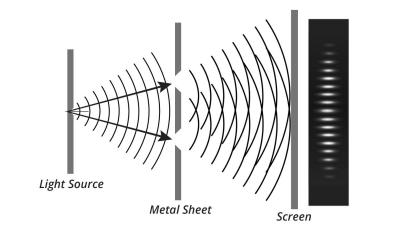
Figure 3. Thomas Young's Double Slit Interference Experiment
Physicists like Max Planck and Einstein proved the particle nature of light. Max Planck derived a formula by assuming that a hypothetical oscillator charged in a cavity that contained black-body(which is an idealized object that absorbs all incident radiation and emits radiation in thermal equilibrium.) radiation could only change its energy in a minimal increment, E, that was proportional to the frequency of its associated electromagnetic wave. In 1905 Einstein proposed that light consists of discrete packets of energy called photons through the photoelectric effects. Each photon carries energy proportional to its frequency (E = hν, where E is energy, h is Planck's constant, and ν is the frequency of light). In the photoemission process, when an electron within some material absorbs the energy of a photon and acquires more energy than its binding energy (called the work function), the electron is able to escape.
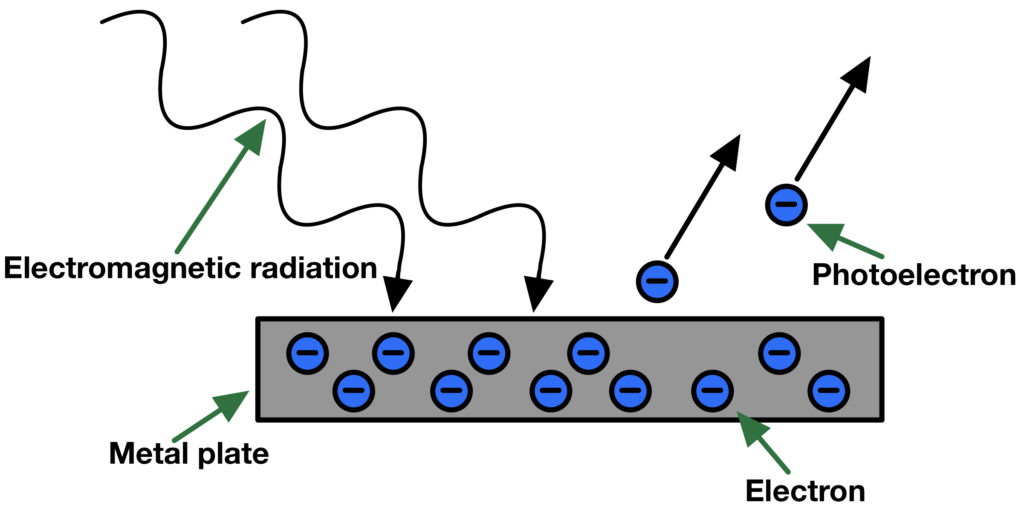
Figure 4. The Photoelectric Effects
Reflection:
Reflection is the change in direction of a wavefront at an interface between two different media so that the wave returns to the medium from which it originated. The law of reflection states that the incident ray, the reflected ray, and the normal (a line perpendicular to the surface at the point of incidence) all lie in the same plane, and the angle at which the light strikes the surface (angle of incidence) is equal to the angle at which it reflects off the surface (angle of reflection). There is also an important concept called Total Internal Reflection. Total internal reflection happens when light enters a medium of a lower refractive index from a medium of a higher refractive index with the incident angle exceeding a certain critical angle θ, in this case, all the incident light will be reflected. The total internal reflection of light is leveraged for fiber communication.
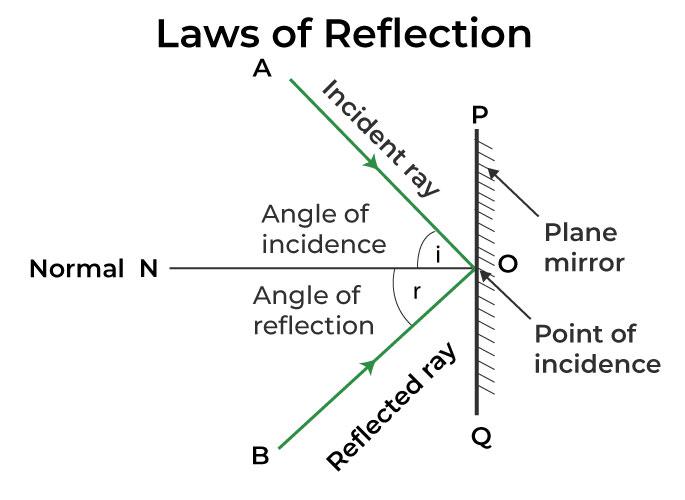
Figure 5. Reflection of Light
Refraction:
Refraction is the bending of a wave as it passes from one medium to another, caused by a change in the wave's speed. When a light wave passes from one medium to another (e.g., from air to glass or from air to water), its speed changes and this change in speed causes the wave to bend. The amount of bending depends on the change in the refractive index between the two media. Snell's Law describes the relationship between the angles of incidence and refraction:
n1Sin(θ1)=n2Sin(θ2)
where n1 and n2 are the refractive indices of the two media, and θ1and θ2are the angle are the angles of incidence and refraction. The law could be simplified as the greater the speed in which the light is transmitted in the media, the greater the angle.
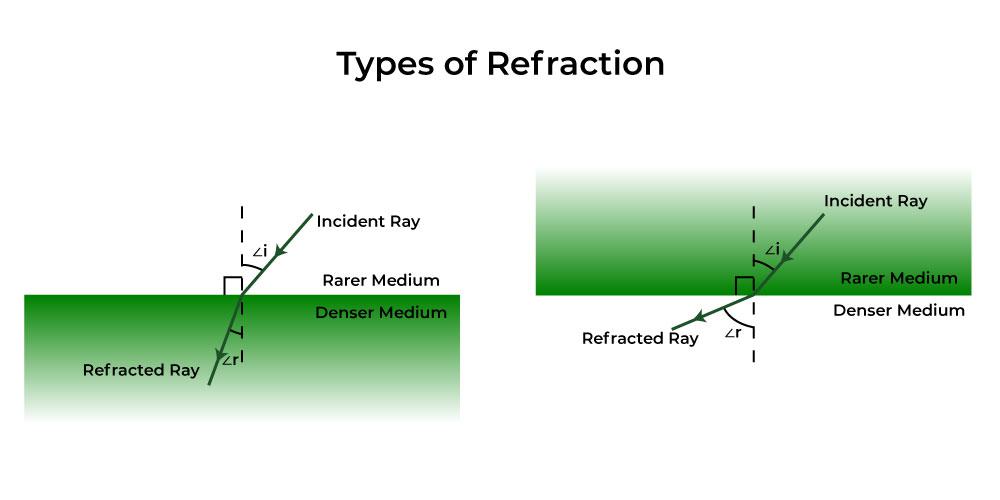
Figure 6. Refraction of Light
Birefringence:
Birefringence is a phenomenon in which a light beam incident on an anisotropic crystal, splits into two beams of light and is then refracted in different directions. When light waves are incident on an anisotropic body, except the light propagates in the direction of the optical axis, birefringence occurs. The light will be decomposed into two polarized lights with oscillation directions perpendicular to each other, different propagation speeds, and unequal refractive indexes. This phenomenon is called birefringence.
Among the two refracted lights, one light abides by the laws of refraction and is called the ordinary ray; the other light does not abide by the laws of refraction and is called the extraordinary ray. The propagation speed of ordinary light is a constant regardless of the propagation direction; the propagation speed of extraordinary light is a variable related to the propagation direction.
Crystals with non-cubic crystal structures are often birefringent, as are plastics under mechanical stress.
Birefringent materials can be further classified into uniaxial and biaxial based on the number of optic axes they possess. Uniaxial materials are birefringent materials with a single optic axis, i.e., a single direction along which the refractive index is the same regardless of the polarization of light, and rotating the material around this axis does not change its optical behavior. Biaxial materials are birefringent materials with two distinct optic axes.
Birefringent crystals are often used to make polarizing optics such as waveplates or retarders, polarizers, and prisms. For instance, a Wollaston prism separates incoming light into two linear polarizations using prisms composed of a birefringent material such as calcite, a waveplate consisting of quartz plates separates incident unpolarized light into its parallel and orthogonal components.
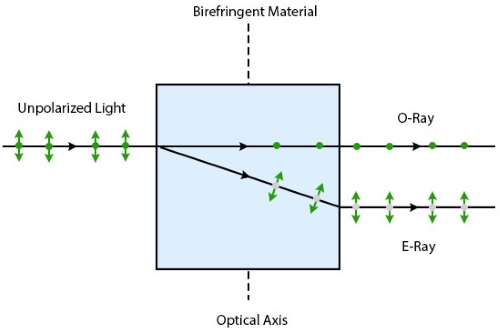
Figure 7. The Birefringence of Light
Diffraction:
Diffraction is the bending or spreading of waves as waves encounter an obstacle or pass through a narrow aperture. When a wave encounters an obstacle or a slit comparable in size to its wavelength, it undergoes diffraction. The extent of diffraction is more pronounced for longer wavelengths. Diffraction patterns can be observed when waves, including light waves, encounter obstacles or openings. The diffraction of light waves was instrumental in experiments that supported the wave nature of light.
The diffraction phenomenon could be better explained using the Huygens-Fresnel Principle, which is a statement that every point on a wavefront is itself the source of spherical wavelets, and the secondary wavelets emanating from different points mutually interfere.
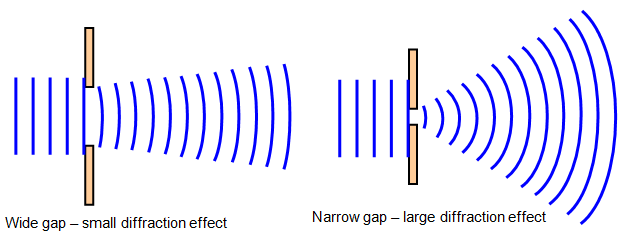
Figure 8. Diffraction
Interference:
Interference is the interaction, or, in other words, superposition, between waves that results in the reinforcement or cancellation of their amplitudes. Interference occurs when two or more waves meet at a point in space. Note that there are certain conditions that must be met for interference to take place, the light sources must have same frequencies (and thus same wavelengths), a constant phase difference, and consistent vibration directions. If the waves are in phase (crest meets crest or trough meets trough), the waves reinforce each other, leading to constructive interference and an increase in amplitude. If the waves are out of phase (crest meets trough), the waves can cancel each other out, resulting in destructive interference and a decrease in amplitude. Interference is a characteristic behavior of wave phenomena and is often observed in optical systems, such as with interference patterns in double-slit experiments.
.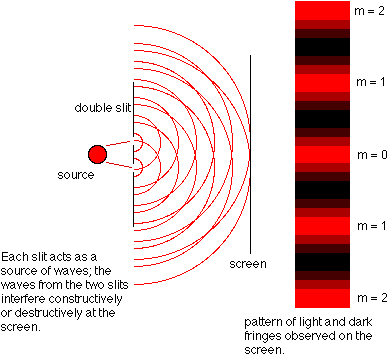
Figure 9. Interference
Optical Elements
Optical elements are components used in optical systems to manipulate and control the behavior of light. These elements play a crucial role in various devices such as cameras, telescopes, microscopes, and other optical instruments. The design and arrangement of optical elements determine the performance and functionality of these systems. There are lots of critical definitions that need to be understood when it comes to optical elements, such as the focal length, the aperture, the optical axis, etc.
The focal length of an optical element, often a lens or a mirror, is the distance between the lens (or mirror) and its focal point, which is the point where parallel lights either converge (in the case of converging lenses or concave mirrors) or appear to diverge from (in the case of diverging lenses or convex mirrors). It is denoted by the symbol 'f.' For converging lenses and concave mirrors, the focal length is positive, indicating that parallel lights converge at the focal point. For diverging lenses and convex mirrors, the focal length is negative, which means that parallel lights appear to diverge from a virtual focal point.
The aperture of an optical system refers to the diameter of the opening through which light passes. In the context of lenses, the aperture is often associated with the iris or diaphragm mechanism that controls the amount of light entering the lens. The aperture size is expressed in terms of f-numbers (f-stop), where a smaller f-number corresponds to a larger aperture and vice versa. Aperture not only regulates the amount of light but also influences depth of field – a larger aperture (smaller f-number) results in a shallower depth of field.
The optical axis is an imaginary line that passes through the center of an optical element, such as a lens or a mirror. It is the principal axis along which light is assumed to travel. The optical axis is crucial in understanding the behavior of light as it passes through or reflects off optical components.
Take the example of a convex lens, when two parallel light rays enter its optical surface, this is what happens next: As the light rays enter the convex lens, the light rays undergo refraction at each surface of the lens, which, as explained in the upper section, is the bending of light as it passes from one medium (e.g., air) into another medium with a different refractive index (e.g., glass). The convex shape of the lens causes parallel rays of light to converge. Parallel rays that strike the lens are brought closer together as they pass through, and the point where these rays meet is called the focal point. If the object is placed at a distance greater than the focal length from the lens, a real and inverted image is formed on the opposite side of the lens. If the object is located at a distance less than the focal length, the image is virtual, upright, and on the same side as the incident light.
Figure 10. How a convex lens focuses lights
The lens equation, which relates the object distance (denoted by 'u'), the image distance (denoted by 'v'), and the focal length ('f'), is given by:
1/f=1/u+1/v
Conclusion
These fundamental optical concepts are the groundwork for understanding the behavior of light and its applications in various technologies. Whether exploring the nature of different types of light or delving into advanced principles like birefringence, a solid grasp of these concepts is essential for anyone venturing into the fascinating world of optics.
Related Articles
Tags: Optical Basics: The Nature of Light and Optical Elements


